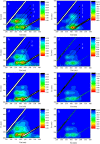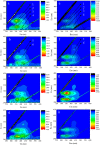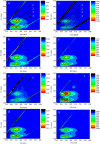Study on Start-Up Membraneless Anaerobic Baffled Reactor Coupled with Microbial Fuel Cell for Dye Wastewater Treatment
- PMID: 34549148
- PMCID: PMC8444317
- DOI: 10.1021/acsomega.1c03560
Study on Start-Up Membraneless Anaerobic Baffled Reactor Coupled with Microbial Fuel Cell for Dye Wastewater Treatment
Abstract
In this study, the antitoxicity performance of the traditional anaerobic baffled reactor (ABR) and the newly constructed membraneless anaerobic baffled reactor coupled with microbial fuel cell (ABR-MFC) was compared for the treatment of simulated printing and dyeing wastewater under the same hydraulic residence time. The sludge performances of ABR-MFC and ABR were evaluated on the dye removal rate, extracellular polymer (EPS) content, sludge particle size, methane yield, and the surface morphology of granular sludge. It was found that the maximum power density of the ABR-MFC reactor reached 1226.43 mW/m3, indicating that the coupled system has a good power generation capacity. The concentration of the EPS in the ABR-MFC reactor was about 3 times that in the ABR, which could be the result of the larger average particle size of sludge in the ABR-MFC reactor than in the ABR. The dye removal rate of the ABR-MFC reactor (91.71%) was higher than that of the ABR (1.49%). The methane production and microbial species in the ABR-MFC system were higher than those in the ABR. Overall, the MFC embedded in the ABR can effectively increase the resistance of the reactor, promote the formation of granular sludge, and improve the performance of the reactor for wastewater treatment.
© 2021 The Authors. Published by American Chemical Society.
Conflict of interest statement
The authors declare no competing financial interest.
Figures









Similar articles
-
Performance and response of coupled microbial fuel cells for enhanced anaerobic treatment of azo dye wastewater with simultaneous recovery of electrical energy.Environ Sci Pollut Res Int. 2023 Aug;30(38):89495-89509. doi: 10.1007/s11356-023-28582-x. Epub 2023 Jul 15. Environ Sci Pollut Res Int. 2023. PMID: 37452255
-
Deciphering the Anode-Enhanced Azo Dye Degradation in Anaerobic Baffled Reactors Integrating With Microbial Fuel Cells.Front Microbiol. 2018 Sep 6;9:2117. doi: 10.3389/fmicb.2018.02117. eCollection 2018. Front Microbiol. 2018. PMID: 30237793 Free PMC article.
-
The effect of polymer addition on granulation in an anaerobic baffled reactor (ABR). Part I: process performance.Water Res. 2002 Feb;36(4):933-43. doi: 10.1016/s0043-1354(01)00315-3. Water Res. 2002. PMID: 11848364
-
[Impact of hydraulic retention time (HRT) in ABR on its operation performance and granular sludge characteristics when treating low-strength wastewater].Huan Jing Ke Xue. 2009 Jul 15;30(7):2022-9. Huan Jing Ke Xue. 2009. PMID: 19775002 Chinese.
-
Upflow anaerobic sludge blanket reactor--a review.Indian J Environ Health. 2001 Apr;43(2):1-82. Indian J Environ Health. 2001. PMID: 12397675 Review.
References
-
- Cai H.; Mei Y.; Chen J.; Wu Z.; Lan L.; Zhu D. An analysis of the relation between water pollution and economic growth in China by considering the contemporaneous correlation of water pollutants. J. Cleaner Prod. 2020, 276, 12278310.1016/j.jclepro.2020.122783. - DOI
-
- Cui M.; Sangeetha T.; Gao L.; Wang A. Efficient azo dye wastewater treatment in a hybrid anaerobic reactor with a built-in integrated bioelectrochemical system and an aerobic biofilm reactor: Evaluation of the combined forms and reflux ratio. Bioresour. Technol. 2019, 292, 12200110.1016/j.biortech.2019.122001. - DOI - PubMed
-
- Assadi A.; Naderi M.; Mehrasbi M. R. Anaerobic–aerobic sequencing batch reactor treating azo dye containing wastewater: effect of high nitrate ions and salt. J. Water Reuse Desalin. 2018, 8, 251–261. 10.2166/wrd.2017.132. - DOI
LinkOut - more resources
Full Text Sources

